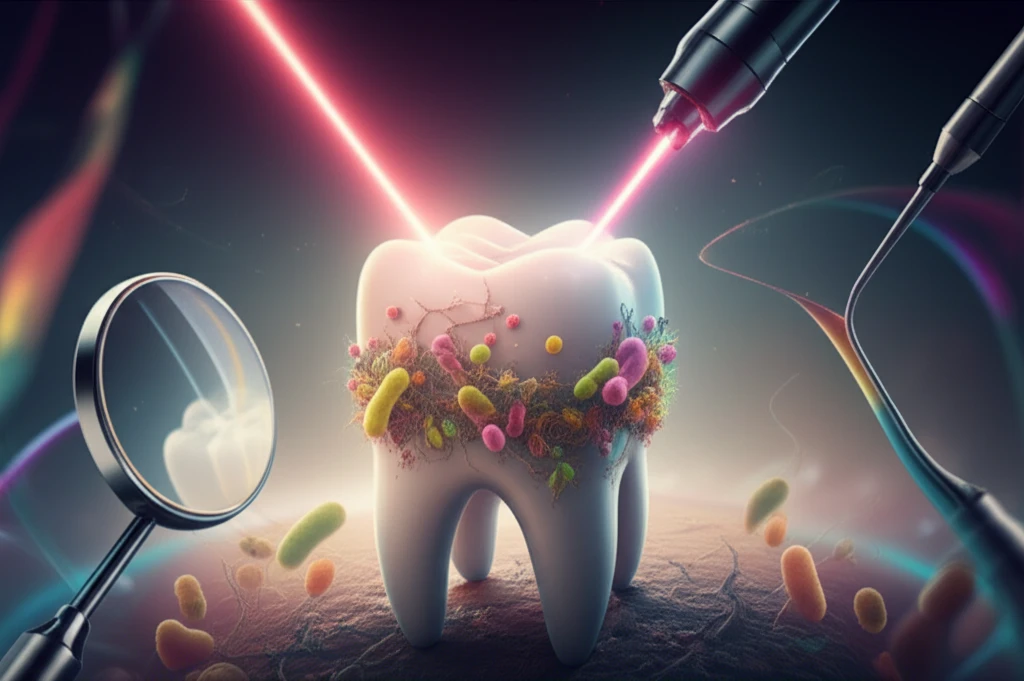
Laser Treatments and Enamel: Unveiling the Truth About Your Teeth
"Are laser treatments the key to stronger teeth, or could they be doing more harm than good? A deep dive into the science of lasers, fluoride, and your enamel."
Laser treatments have emerged as a popular method for preventing dental caries, promising a significant reduction in mineral loss within the oral cavity. The appeal is clear: a high-tech solution for a common problem. But what truly happens when these powerful beams meet your delicate enamel? Multiple theories attempt to explain the preventive effects, all rooted in the temperature increase within the treated tissue, leading to both structural and chemical alterations in the enamel and dentin.
The primary chemical change involves the reduction of CO3 components in the phosphate position and the condensation of acid phosphate ions into pyrophosphate ions. When exposed to higher temperatures, thermal re-crystallization and crystal size growth occur, allowing pyrophosphate to react with apatite and form PO4. This complex process is believed to render the enamel less soluble to acids, providing a protective shield against decay.
Another hypothesis suggests that the incomplete decomposition of the organic matrix within the enamel obstructs the inter- and intraprismatic spaces. This obstruction hinders acid diffusion into the inner layers of enamel, delaying demineralization when the enamel surface reaches approximately 400 °C (5). Simultaneously, the decrease in enamel porosity occurs due to surface melting, a process that begins around 1200 °C (6). It’s a delicate balance: enough heat to be effective, but not so much that it damages the tissue.
The Delicate Balance: How Lasers Interact with Fluoride on Your Enamel

The study aimed to demystify the effects of high-intensity lasers on tooth enamel, particularly when combined with fluoride varnish. Researchers evaluated surface roughness and bacterial adhesion—two critical factors in dental health—after different laser treatments. Eighty bovine enamel fragments were divided into eight groups. One group received no treatment, while another was treated with a 5% fluoride varnish. The remaining groups were irradiated with Er:Cr:YSGG, Nd:YAG, or diode lasers, with or without fluoride varnish.
- Lasers Alone: Irradiation without fluoride varnish showed no significant change in surface roughness or bacterial adhesion compared to untreated samples.
- Lasers and Fluoride: Samples treated with laser irradiation and fluoride varnish exhibited significantly higher surface roughness and bacterial adhesion. The presence of pigments in the varnish seemed to amplify the laser's effect on the enamel surface, leading to increased ablation.
Protecting Your Pearly Whites: Key Takeaways
The study underscores the importance of understanding the complex interactions between dental treatments and their potential side effects. While lasers can be a valuable tool in preventing tooth decay, they are not a one-size-fits-all solution. The combination of lasers and fluoride varnish can inadvertently increase surface roughness, making enamel more susceptible to bacterial adhesion. Always consult with your dentist to determine the best approach for your unique dental needs. Maintaining good oral hygiene and regular dental visits remain the cornerstones of a healthy smile.
